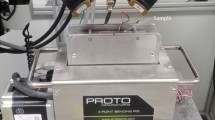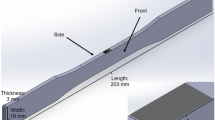Abstract
In a previously developed method for estimating Young’s modulus E by depth-sensing indentation with spherical-tipped Berkovich indenter, the E value is deduced from several functional relationships (established by finite element analysis) relating nominal hardness/reduced elastic modulus ratio (Hn/Er) and elastic work/total work ratio (We/W). These relationships are specified for different absolute bluntness/maximum displacement ratios (Δh/hm). This paper reports the generalization of the method by proposing a function to replace all the above mentioned Hn/Er−We/W relationships. The function contains only a parameter Vr ≡ Videal/Vblunt instead of Δh/hm, where Videal is defined as the indented volume bounded by the cross-sectional areas measured at the maximum displacement hm for an ideally sharp indenter, and Vblunt is that of the real indenter. The use of Vr to replace Δh/hm is for the purpose of extending the application of the method for non-spherical tipped Berkovich indenters. The effectiveness of the method for materials of prominent plasticity was demonstrated by performing tests on carbon steel and aluminum alloy using three Berkovich indenters with different tip shapes.
Similar content being viewed by others
References
A.C. Fischer-Cripps: Nanoindentation (Springer-Verlag, New York, NY, 2004), p. 39.
W.C. Oliver and G.M. Pharr: An improved technique for determining hardness and elastic modulus using load and displacement sensing indentation experiments. J. Mater. Res. 7, 1564 (1992).
G.M. Pharr, W.C. Oliver, and F.R. Brotzen: On the generality of the relationship among contact stiffness, contact area, and elastic modulus during indentation. J. Mater. Res. 7, 613 (1992).
W.C. Oliver and G.M. Pharr: Measurement of hardness and elastic modulus by instrumented indentation: Advances in understanding and refinements to methodology. J. Mater. Res. 19, 3 (2004).
Y-T. Cheng, Z. Li, and C-M. Cheng: Scaling approach to modeling indentation measurements, in Fundamentals of Nanoindentation and Nanotribology II, edited by S.P. Baker, R.F. Cook, S.G. Corcoran, and N.R. Moody (Mater. Res. Soc. Symp. Proc. 649, Warrendale, PA, 2001), p. Q1.1.
Y-T. Cheng and C-M. Cheng: Relationships between hardness, elastic modulus, and the work of indentation. Appl. Phys. Lett. 73, 614 (1998).
C-M. Cheng and Y-T. Cheng: On the initial unloading slope in indentation of elastic-plastic solids by an indenter with an axisymmetric smooth profile. Appl. Phys. Lett. 71, 2623 (1997).
D. Ma, C.W. Ong, and S.F. Wong: New relationship between Young’s modulus and nonideally sharp indentation parameters. J. Mater. Res. 19, 2144 (2004).
J.J. Vlassak and W.D. Nix: Measuring the elastic properties of anisotropic materials by means of indentation experiments. J. Mech. Phys. Solids 42, 1223 (1994).
J.J. Vlassak and W.D. Nix: Indentation modulus of elastically anisotropic half spaces. J. Mech. Phys. Solids 67, 1045 (1993).
J.J. Vlassak, M. Ciavarella, J.R. Barber, and X. Wang: The indentation modulus of elastically anisotropic materials for indenters of arbitrary shape. J. Mech. Phys. Solids 51, 1701 (2003).
J.P. Hirth and J. Lothe: Elastic Constants, in Theory of Dislocations (Krieger Publishing Company, Malabar, FL, 1982), p. 837.
A. Bolshakov and G.M. Pharr: Influences of pileup on the measurement of mechanical properties by load and depth-sensing indentation techniques. J. Mater. Res. 13, 1049 (1998).
Y-T. Cheng and C-M. Cheng: Scaling relationships in indentation of power-law creep solids using self-similar indenters. Philos. Mag. Lett. 81, 9 (2001).
T. Chudoba and F. Richter: Investigation of creep behavior under load during indentation experiments and its influence on hardness and modulus results. Surf. Coat. Technol. 148, 191 (2001).
Author information
Authors and Affiliations
Rights and permissions
About this article
Cite this article
Ma, D., Ong, C.W., Wong, S.F. et al. New method for determining Young’s modulus by non-ideally sharp indentation. Journal of Materials Research 20, 1498–1506 (2005). https://doi.org/10.1557/JMR.2005.0193
Received:
Accepted:
Published:
Issue Date:
DOI: https://doi.org/10.1557/JMR.2005.0193




